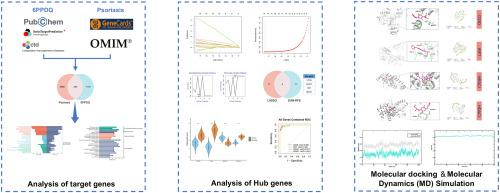通过网络毒理学、机器学习和多维生物信息学分析探索6PPDQ暴露对银屑病的毒理学影响
IF 7.3
2区 环境科学与生态学
Q1 ENVIRONMENTAL SCIENCES
引用次数: 0
摘要
N-(1,3-二甲基丁基)-N ' -苯基-对苯二胺醌(6PPDQ)是轮胎抗氧化剂6-PPD的衍生物,近年来成为备受关注的环境污染物。本研究采用网络毒理学框架探讨其在银屑病中的潜在作用。通过计算机靶点预测和疾病数据库整合,确定了290个重叠的6ppdq -银屑病靶点。基因本体和KEGG通路分析暗示MAPK和TNF信号,以及IL-23/Th17炎症轴-银屑病发病的关键途径。机器学习(LASSO和SVM-RFE)对四个核心基因(CD3D, IRF7, NR3C1, HDAC1)进行了优先排序。这些基因在银屑病转录组(GSE13355)中表现出显著的表达改变,并表现出很强的诊断性能(AUC > 0.99)。免疫浸润分析(ssGSEA)和单细胞RNA-seq数据将这些基因与银屑病病变中的促炎t细胞、树突状细胞(dc)和角化细胞联系起来。分子对接显示,6PPDQ与所有4种蛋白都具有高亲和力结合,其中NR3C1表现出最强的相互作用(−8.1 kcal/mol)。分子动力学模拟证实了该配合物的稳定性。我们建立了一个不良结果通路模型,通过这些核心基因将6PPDQ暴露与银屑病免疫失调联系起来。总的来说,研究结果表明6PPDQ可能通过破坏关键的免疫炎症调节因子(尤其是nr3c1)而加剧牛皮癣,从而为环境污染物如何促进疾病进展提供了机制见解。本文章由计算机程序翻译,如有差异,请以英文原文为准。

Exploring the Toxicological Impact of 6PPDQ Exposure on Psoriasis through Network Toxicology, Machine Learning, and Multidimensional Bioinformatics Analysis
N-(1,3-Dimethylbutyl)-N′-phenyl-p-phenylenediamine quinone (6PPDQ), a derivative of the tire antioxidant 6-PPD, has recently emerged as an environmental contaminant of concern. This study employed a network toxicology framework to explore its potential role in psoriasis. Through in silico target prediction and disease database integration, 290 overlapping 6PPDQ–psoriasis targets were identified. Gene Ontology and KEGG pathway analyses implicated MAPK and TNF signaling, along with the IL-23/Th17 inflammatory axis—key pathways in psoriasis pathogenesis. Machine learning (LASSO and SVM-RFE) prioritized four core genes (CD3D, IRF7, NR3C1, HDAC1). These genes displayed markedly altered expression in psoriatic transcriptomes (GSE13355) and demonstrated strong diagnostic performance (AUC > 0.99). Immune infiltration analysis (ssGSEA) and single-cell RNA-seq data linked these genes to pro-inflammatory T-cells, dendritic cells (DCs), and keratinocytes in psoriatic lesions. Molecular docking revealed high-affinity binding of 6PPDQ to all four proteins, with NR3C1 exhibiting the strongest interaction (−8.1 kcal/mol). Molecular dynamics simulations confirmed the stability of this complex. An adverse outcome pathway model was established, linking 6PPDQ exposure to immune dysregulation in psoriasis via these core genes. Collectively, the findings suggest that 6PPDQ may exacerbate psoriasis by disrupting key immune-inflammatory regulators—particularly NR3C1—thereby offering mechanistic insights into how environmental pollutants contribute to disease progression.
求助全文
通过发布文献求助,成功后即可免费获取论文全文。
去求助
来源期刊

Environmental Pollution
环境科学-环境科学
CiteScore
16.00
自引率
6.70%
发文量
2082
审稿时长
2.9 months
期刊介绍:
Environmental Pollution is an international peer-reviewed journal that publishes high-quality research papers and review articles covering all aspects of environmental pollution and its impacts on ecosystems and human health.
Subject areas include, but are not limited to:
• Sources and occurrences of pollutants that are clearly defined and measured in environmental compartments, food and food-related items, and human bodies;
• Interlinks between contaminant exposure and biological, ecological, and human health effects, including those of climate change;
• Contaminants of emerging concerns (including but not limited to antibiotic resistant microorganisms or genes, microplastics/nanoplastics, electronic wastes, light, and noise) and/or their biological, ecological, or human health effects;
• Laboratory and field studies on the remediation/mitigation of environmental pollution via new techniques and with clear links to biological, ecological, or human health effects;
• Modeling of pollution processes, patterns, or trends that is of clear environmental and/or human health interest;
• New techniques that measure and examine environmental occurrences, transport, behavior, and effects of pollutants within the environment or the laboratory, provided that they can be clearly used to address problems within regional or global environmental compartments.
 求助内容:
求助内容: 应助结果提醒方式:
应助结果提醒方式:


